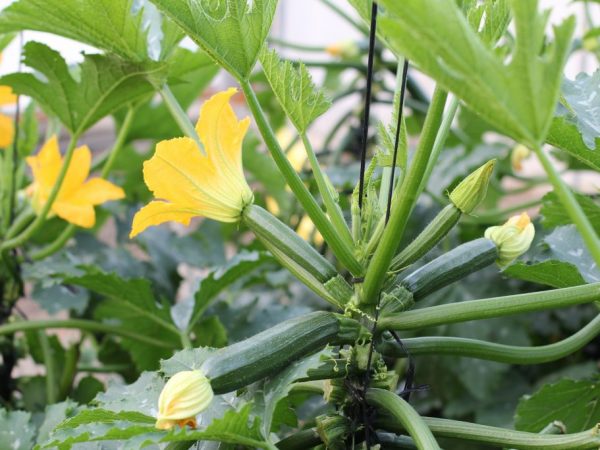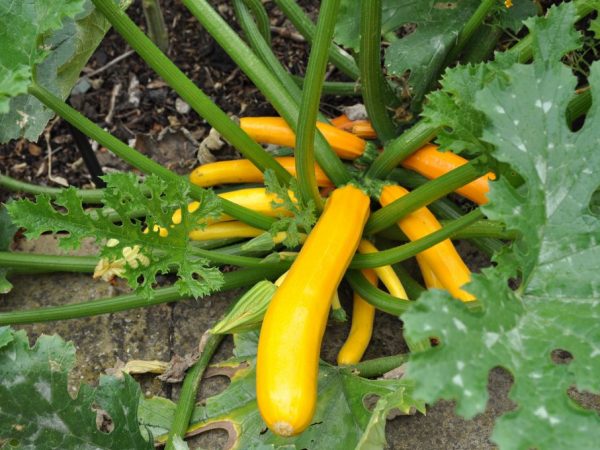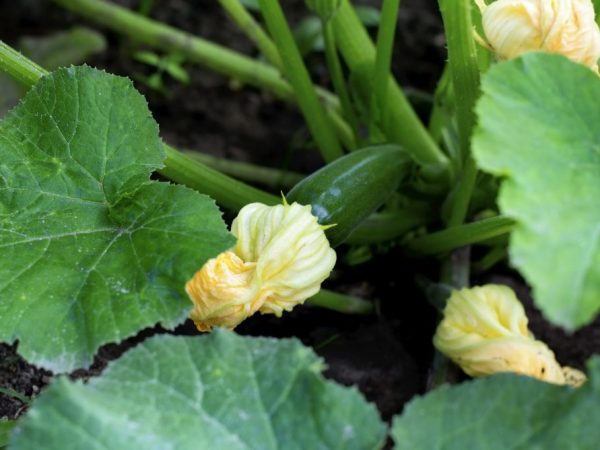Varieties of bush zucchini
This type of pumpkin vegetable was bred by breeders for a special purpose. Usually this crop takes up a lot of space in the garden, which makes it difficult to grow other products. Shrub zucchini grow compactly, their leaves and stem system do not curl, which significantly saves the territory for their planting.

Varieties of bush zucchini
The best varieties
There are several of the most common varieties of such zucchini that are in great demand:
- a striking representative is the Aeronaut variety. This species is small in size, the length of one fruit is 14-15 cm, and the weight is 1.3-1.5 kg. Zucchini is green in color with barely noticeable white vertical stripes. It is grown mainly in greenhouses. Begins to bear fruit from 46 days. From one bush, you can collect 7-7.5 kg of vegetables per season, if there is enough space for their development. The fruits tolerate transportation well and are stored for a long time;
- this variety is quite unusual, its name reflects its color - White. The species is distinguished by its early maturity, because the crop of zucchini can be harvested already a month after planting the crop. The fruit is small, oval and up to 1 kg in weight. Its rind is rich white and the flesh is creamy and firm. This variety is recommended for use by young children and people with diabetes mellitus;
- Tsukesha. Its fruits are bright green, dense, small white specks are visible on the peel. The plant develops quickly, bears fruit soon and is characterized by high yields - 12 kg of vegetables can be harvested from one bush per season. The advantage of this species is that it can easily tolerate frost and can be transported. Zucchini are stored after harvesting for 2 weeks;
- The Beloplodny variety begins to yield a harvest one and a half months after planting, and up to 9 kg of vegetables can be harvested from one bush. The culture can grow quietly in a darkened area. One zucchini weighs up to 1 kg. More often it is used for winter harvesting;
- Zolotinka. It is distinguished by its special taste, due to which the vegetable is used for baby food. The fruits are small, their weight is only 400 g, up to 8 kg of vegetables can be harvested from one bush. The rind is bright yellow, rich in color, sweet, with a pleasant aroma. Harvested in 50 days, it can be stored for 2 months.
Early maturing varieties
It is worth considering those varieties of bush zucchini that are among the first to ripen. The early ripening of fruit crops is usually a month or more. Such plants are great for northern regions, where the summer is very short, and in the southern regions, these types of vegetables begin to be planted when the early greens are harvested.
Iskander F1
The variety was bred not so long ago in Holland. It bears fruit already on the 40th day after planting and is distinguished by a special yield - 17 fruits can be harvested from one bush. The vegetables are small, their weight is only 500-700 g, and the length is 20 cm.The color is light green, white blotches are visible on the peel. The squash is cylindrical, narrow and smooth.
They have a special taste, because their flesh is tender and tasty, its color is either pale green or cream. The fruits can easily outgrow, from this their taste does not change in any way.
Karisma F1
A type of early maturing bush squash that ripens 40-45 days after planting. They are not distinguished by anything special in appearance: a cylindrical oblong shape and a light green color. The fruits are slightly ribbed and small in size. They have a pleasant white flesh - juicy, sweetish. The bushes of the culture are compact.
Zucchini perfectly tolerate transportation, are stored for a long time, and when ripe they have a stable immunity to diseases. This variety is used both raw and in heat treatment.
Ball
It is original in appearance because its shape is more like a watermelon than a vegetable marrow. In addition, it is dark green with white vertical stripes. This bush squash is large in size, the weight of one fruit is up to 2 kg.
The crop can be harvested 50 days after planting. Vegetables are distinguished by excellent taste and unforgettable aroma, fruits are suitable for stuffing.
Medium ripening varieties

Medium-ripening varieties will delight you with an early harvest
Bush crops of medium-ripening zucchini are distinguished by their yield, which begins from the 55th day after planting.
Kuand
This species is high-yielding, resistant to cold and rainy weather. Fruits ripen 48-60 days after planting. Zucchini are small, egg-shaped. Their maximum weight is 1 kg.
The color of the peel is bright light green with dark green vertical stripes. It is thin, but if the vegetable is overripe, it becomes coarser.
The pulp is creamy, juicy and firm. The variety is resistant to various diseases. It is used for conservation and eaten raw.
Gribovsky 37
A popular product for the market and supermarket, because its fruits can be easily transported and stored for a long time. Ripen in 50-60 days. Their yield level is high, the peel is light in color, soft and aromatic. If the vegetable is overripe, it changes its properties and becomes bitter.
The description suggests that the variety is resistant to diseases and pests. Often grown in the Moscow region.
Black handsome
An unusual variety of zucchini, but its ripeness is noted as medium. The bushes of the vegetable are compact, but they have a lot of leaves, under which small fruits are hidden. Their length is 22 cm, and their weight is up to 1 kg.
The skin of the vegetable is thin, has a rich dark green color, which is why it got its unusual name. Up to 5 fruits ripen on one bush, from 1 sq. m you can collect them up to 20 kg. The zucchini is cylindrical in shape, shiny and smooth. It is characterized by resistance to pests.
Late zucchini
The fruits of late-ripening varieties of bush squash are more suitable for cold regions. There they are used for harvesting for the winter, moreover, they have a fairly long shelf life after harvesting.
Spaghetti raviolo
An interesting variety for many gardeners. The plant in the form of a bush is small and neat, fits even in a small area of the garden. The fruit of the vegetable itself is unusual and in appearance does not at all look like a vegetable marrow. It is small in size, moreover, a maximum of 8 ovaries are formed on the bush.
The peel is bright orange, like an orange, the flesh is the same color. What is curious - it tastes like ordinary zucchini, which is used for canning, stuffing, or just as a separate dish. The vegetable got its name due to the property of overripe fruits to exfoliate into fibers that resemble spaghetti.
Tivoli F1
These fruits grow large on the bush, they need an area with space to grow. Such zucchini ripen 4 months after planting. To prevent the fruits from falling off, the culture must be irrigated regularly. The vegetable is medium in size, round in shape and yellow in color.When cooked, it can break down into fibers that resemble spaghetti.
Lagenaria
An interesting type of zucchini, which is not so often found in vegetable gardens. He was taken out in Vietnam. Overripe fruits tend to dry out, forming a cavity inside, because of which this vegetable previously served as material for vessels. This variety is exotic, and it ripens for a long time.
One bush grows 2-3 zucchini. They have an oblong narrowed shape, the length of one fruit is 35-40 cm. Their color is light green with a white transition or blotches.
Differences between domestic and foreign varieties

Domestic varieties are resistant to frost
Domestic varieties of bush squash are frost-resistant. This is their only advantage over foreign species. Our zucchini do not have such a presentable presentation as imported ones, they do not differ in special beauty and high taste. But they grow quickly and do not need constant care.
With imported varieties, everything is different. Their productivity is much higher, they noticeably benefit from taste. Foreign representatives of fruit crops have a thin skin, excellent presentation and are stored for a long time.
They have a drawback - such species do not grow in all territories, they need proper care. If you plant zucchini and leave them unattended, during the setting of fruits, the plant will simply throw them off and the crop will be lost.
A distinctive feature between the two types of zucchini is that foreign fruits can remain on the plant for a long time and not lose their qualities. Domestic representatives quickly lose them when they are overripe.
Growing tips
Zucchini are planted with seeds. If the climate in the region is cold, for example, in Siberia, then it is better to sow the material in greenhouses, and in regions with predominantly positive temperatures, they are planted immediately in open ground.
The planting site should not be blown by the wind all the time, it should also have a moderately sunny color and a little shade from other plants. Planting bush varieties of zucchini in one place can be no more than a year. Re-sowing seeds on the previous bed is possible only after 3 years.
The soil for the culture is chosen fertile, with a neutral level of acidity. Before planting, be sure to fertilize it with organic components: humus or manure. Seeds are planted only in warm ground, because they can sprout at a temperature of at least 12 ° C.
If the soil has not warmed up well, but the seeds have already been planted, then the likelihood that they will sprout is reduced. Morning frosts affect the germination of the plant, so it needs to be protected. Agrofibre is an excellent solution.
Before planting in open ground, all seeds settle in water for several hours. Zucchini is sown using a special method, allocating for them a quadrant area measuring 50 by 70 cm. Dig holes manually, 3 seeds are dipped into each of them.
When the plant rises, the largest of the 3 stems is selected and left. Top dressing is carried out twice using organic, mineral and nitrogen fertilizers; in cold regions, hilling is recommended in the phase of 4-5 leaves.
Water the plants when they begin to bloom and ripen. 10-12 days before harvesting, irrigation is stopped so that the vegetables do not rot, and also so that the amount of water in the fruits is minimal, which will increase their shelf life.
Bush squash are common in different territories. They were bred artificially, which is why they are adapted to different climatic conditions. Their main advantage is that they do not occupy a large area, but they give a high yield and have excellent taste.

